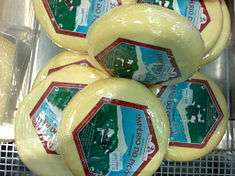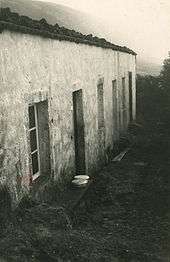Queijo do Pico
| Cheese of Pico | |
|---|---|
 | |
| Other names | Queijo do Pico |
| Country of origin |
|
| Region |
|
| Town | Lajes do Pico, Madalena, São Roque do Pico |
| Source of milk | Cows |
| Pasteurised | No |
| Texture | Soft |
| Fat content | 45-49 |
| Aging time | 20-30 days |
| Certification | PDO October 1996 |
Cheese of Pico (Portuguese: Queijo do Pico) is a cheese originating from the island of Pico in the Portuguese archipelago of the Azores. It has been classified as a "Denomination of Protected Origin", in accordance with the laws of the European Union since October 1996.[1][2]
History

It is unknown as to when the Queijo do Pico was first made, but there are references to its fabrication dating as far back as the end of the 18th century; the manner of its preparation has been handed down to descendents since it was first cured.
Characteristics
This cured cheese is produced from cow milk, from a slow coagulation process that takes between 20 to 30 days. The cheese is produced in cylindrical formats, ranging from diameters between 16 centimetres (6.3 in) to 17 cm (6.7 in) and heights of 2 cm (0.79 in) to 3 cm (1.2 in), while weights average 650 grams (1.43 lb) to 800 g (1.8 lb). Its fat content ranges from between 45% and 49%, and is considered a fatty cheese. The ripening of the cheese forms a yellow exterior irregular crust and yellowish-white, soft and pasty interior. Pico cheese has a salty taste and a, characteristically, intense aroma.
See also
References
- Notes
- ↑ "Queijo do Pico" (in Portuguese). Ponta Delgada (Azores), Portugal. 2004–2012. Retrieved 19 April 2012.
- ↑ Queijo do Pico in the DOOR database of the European Union. Retrieved 2014-03-14.
- Sources
- GRA (ed.), Queijo do Pico: Denominação de Origem, Caderno de Especificações (PDF) (in Portuguese), Lajes do Pico (Azores), Portugal: Governo Regional dos Açores, retrieved 19 April 2012